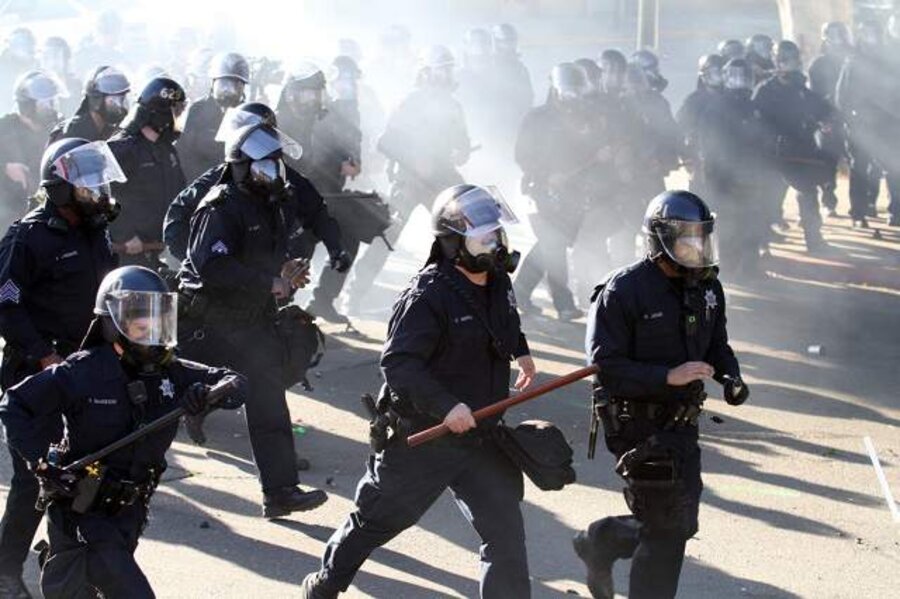Weekend violence in Oakland: Is Occupy movement back, or broken?
Loading...
| Los Angeles
As Oakland, Calif., puts the Occupy movement back in the national spotlight with TV images of flag-burning and violent police clashes, a media war is under war to define the very nature of the Occupy movement itself, with Oakland as its potential flag-bearer.
Competing narratives as to what transpired over the weekend have been emerging in the digisphere and on YouTube. Depending on whose press releases or tweets you believe – which alternately portray the police or protesters as the violent instigators – this weekend could either be the black eye that becomes the Waterloo of the four-month-old global protest movement or the signal bell of its reawakening.
The struggle to define the group’s actions is already playing out in an escalating rhetorical war. On Monday, Oakland Mayor Jean Quan told the local CBS affiliate she planned to call “some of the national leadership of Occupy this week to say that the Oakland group is not nonviolent,” with the hope that the larger group will distance itself.
At the same time, Occupy Oakland media team member Shake Anderson dismisses Mayor Quan’s charge, saying simply, “We did not attack the police, they attacked us.”
On Saturday, according to an Occupy Oakland statement, protesters began a series of actions attempting to put “a vacant building to better use,” which Mr. Anderson acknowledges can be seen as trespassing. The site in question has been vacant for six years, according to the statement, which asserts that the Occupy group had voted to mount a nonviolent action to turn the space into a social center and headquarters of Occupy Oakland.
[ Video is no longer available. ]
The crowd was met with an overwhelming police force, says Anderson, a force buttressed by mutual aid from 13 surrounding cities.
“We did not throw anything," says Anderson.
However, the Oakland Police Department (OPD), which describes the events in its own release, said that as activists began to march, “the first dispersal order was given as the crowd began destroying construction equipment and fencing.”
“Officers were pelted with bottles, metal pipe, rocks, spray cans, improvised explosive devices and burning flares,” the OPD release said, adding that police “deployed smoke and tear gas.”
Anderson says simply, “This is a lie.”
By the end of the evening, some 400 protesters had been arrested and several police officers treated for injuries.
The OPD has not returned calls for comment. Its official statements say the protesters initiated the violent actions.
Reports from others on the ground paint a very different picture. Dan Miskulin, a contractor from San Francisco, describes a situation that many caught up in the action tweeted, texted, and blogged – saying that the police created an impossible situation for the protesters. According to these reports, police in riot gear surrounded the protesters, repeatedly funneling them into first a park and then an area by the YMCA from which they had no exit.
“I watched people go up to the officers and ask how they could leave, and the officers told them to go to another spot where the officers would pass them on. People were panicking after the tear gas,” Mr. Miskulin says.
[Editor's note: The original versionof this article reported that Mr. Miskulin said, "People were panicking after the tear gas and rubber bullets."]
As for projectiles being hurled at the police, notes Drexel University political scientist George Ciccareillo-Maher, who has been following the events closely, “protesters tossed back the tear gas canisters that were being shot at them by the police.”
Perhaps one of the most incendiary images from the weekend’s skirmishes is the American flag in flames. But, points out Scott Kimball, secretary for the board of directors of Iraq Veterans Against the War, which has worked with Occupy protesters, “burning the flag is a protected form of political speech.”
But images can take on a life of their own, says Wojtek Zarzycki, managing director and strategist for Optimal Investing, a boutique financial services firm in New York that specializes in high-net-worth individuals.
“The vandalism and arrests will be more than just a black eye for the movement as now these acts are associated with its protesting,” he says via e-mail. “The influence of its actions is now lessened and the possibility of it regaining its status as the movement of the 99 percent is less likely.”
Most of the 99 percent whom the Occupy movement claims to represent, he adds, “have nothing to do with violence, nothing to do with vandalism, and only want fairness and equality.”
Prognosticators need to be careful about glib interpretations of media images, says Ted Morgan, author of “What Really Happened to the 1960s: How Mass Media Culture Failed American Democracy.”
“Millions of Americans will see images that they find anywhere from stimulating to frightening to repugnant,” he says via e-mail. Powerful backlash forces will do what they have been doing for 48 years now, he says, “using these images to foist on the wider public a distorted reality about the movements and their meanings.”
Professor Ciccariello-Maher suggests another scenario – that Oakland may be the start of the Occupy movement’s next phase as the election season picks up. Whatever interpretation prevails in Oakland may not matter. The weekend’s events may be just the flashpoint the movement needs to emerge from a somewhat quiet winter, he adds.







